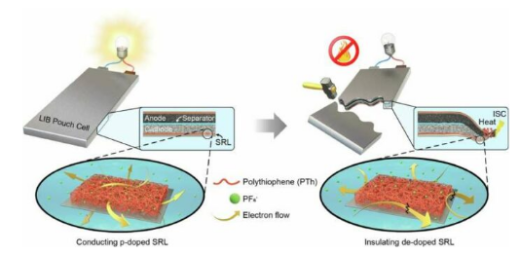The material designed to prevent thermal runaway in batteries enhances safety and could transform the technology industry.
Engineers and materials scientists at LG Chem, the largest chemical company in Korea, have created a material that could significantly lower the risk of thermal runaway and subsequent fires in batteries.
In recent years, there have been numerous reports of battery fires in smartphones and cars, often due to thermal runaway, a condition where the anode and cathode inside a battery become too close or even touch. This causes a short circuit, generating heat and potentially leading to a fire. To combat this, engineers at LG Chem, Korea’s largest chemical company, have developed a thin material that acts as a barrier between the cathode and collector to prevent thermal runaway.
The innovative material works by interrupting the flow of electricity when the battery begins to overheat. Incorporating electronic sensors for this purpose was deemed impractical due to size and vulnerability to heat. Instead, the team designed a thin, conductive material that ceases conductivity at a specific temperature threshold.
This new material, dubbed the Safety Reinforcement Layer (SRL), is a metal composite only one micrometer thick. It was incorporated into a standard battery and subjected to extensive testing. Under normal operating temperatures ranging from 90°C to 130°C, the SRL conducted electricity as usual. However, as temperatures increased, the resistance also rose by 5,000 ohms per degree Celsius, effectively reducing the current. Conversely, when temperatures dropped, the resistance diminished.
Real-world testing included extreme conditions such as driving a nail through the battery or compressing it under a heavy weight—both scenarios typically lead to fires. Remarkably, batteries equipped with the SRL either didn’t catch fire or any small fire that started was quickly suppressed.
The LG Chem team is continuing to test the SRL in various battery sizes and types, aiming to market this technology to battery manufacturers soon.
Reference: In Taek Song et al, Thermal runaway prevention through scalable fabrication of safety reinforced layer in practical Li-ion batteries, Nature Communications (2024). DOI: 10.1038/s41467-024-52766-9
Original article source:
https://www.electronicsforu.com/news/innovative-material-developed-to-prevent-battery-fires
FAQ
1. Why do batteries catch fire?
Battery fires, especially in lithium-ion batteries, are typically caused by thermal runaway—a chain reaction where an increase in temperature leads to further temperature rise, causing the battery to overheat, vent gas, and sometimes ignite. This can happen due to short circuits, overcharging, or physical damage.
2. What is the innovative material that prevents battery fires?
The innovative material is likely a flame-retardant or heat-resistant compound integrated into the battery’s electrolyte or separator. This material can prevent the propagation of thermal runaway by either absorbing heat, suppressing the reaction, or forming a protective barrier to stop the spread of the fire.
3. How does this new material work to prevent fires?
The material may have properties that either absorb excess heat or release a fire-suppressing substance when a critical temperature is reached. Alternatively, it could be designed to strengthen the battery’s internal components, reducing the likelihood of short circuits or other failures that lead to fires.
4. What types of batteries can use this new material?
This material is most likely designed for lithium-ion batteries, as they are widely used in consumer electronics, electric vehicles (EVs), and energy storage systems. However, it may also be adaptable to other battery chemistries that face similar fire risks.
5. Will this material affect battery performance?
The goal of innovative fire-prevention materials is to maintain or even improve battery performance while enhancing safety. The material would ideally not compromise the energy density, charging speed, or lifespan of the battery, but there may be a trade-off between safety and performance in some cases.
6. Is this material commercially available?
Depending on the stage of development, the material may be in the research phase, undergoing testing, or possibly close to commercialization. This will vary depending on the specific company or research institution developing the material. Some safety-enhancing materials have already been incorporated into next-generation batteries.
7. What industries stand to benefit the most from this innovation?
Electric vehicle (EV) manufacturers, consumer electronics companies, and energy storage systems are the primary industries that would benefit from fire-preventing battery materials. Safer batteries could also have significant impacts in aviation, medical devices, and even the renewable energy sector, where large battery storage systems are used.
